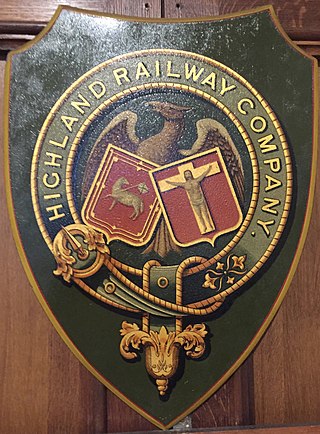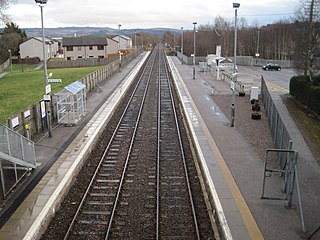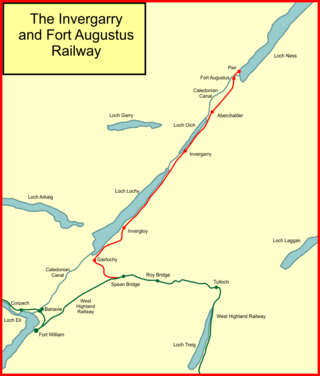Related Research Articles

The Highland Railway (HR) was one of the smaller British railways before the Railways Act 1921, operating north of Perth railway station in Scotland and serving the farthest north of Britain. Based in Inverness, the company was formed by merger in 1865, absorbing over 249 miles (401 km) of line. It continued to expand, reaching Wick and Thurso in the north and Kyle of Lochalsh in the west, eventually serving the counties of Caithness, Sutherland, Ross & Cromarty, Inverness, Perth, Nairn, Moray and Banff. Southward it connected with the Caledonian Railway at Stanley Junction, north of Perth, and eastward with the Great North of Scotland Railway at Boat of Garten, Elgin, Keith and Portessie.

Dingwall railway station serves Dingwall, Scotland. It is located just south of the junction of the Far North Line and the Kyle of Lochalsh Line, and is managed and served by ScotRail. The station is 18 miles 58 chains (30.1 km) from Inverness, and is the zero point for the Kyle of Lochalsh Line. It is sited after Conon Bridge heading northbound, with the next station being either Garve or Alness.

Inverness railway station is the railway station serving the Scottish city of Inverness. It is the terminus of the Highland Main Line, the Aberdeen–Inverness line, the Kyle of Lochalsh line and the Far North Line.

Stirling railway station is a railway station located in Stirling, Scotland. It is located on the former Caledonian Railway main line between Glasgow and Perth. It is the junction for the branch line to Alloa and Dunfermline via Kincardine and is also served by trains on the Edinburgh to Dunblane Line and long-distance services to Dundee and Aberdeen and to Inverness via the Highland Main Line.

Muir of Ord railway station is a railway station on the Kyle of Lochalsh Line and the Far North Line, serving the village of Muir of Ord in the Highland council area of Scotland. The station is 13 miles 4 chains from Inverness, between Beauly and Conon Bridge, and is the location of the sole remaining passing loop on the single line between Dingwall and Inverness.

Ardgay railway station is a railway station serving the village of Ardgay and its neighbour Bonar Bridge in the Highland council area of Scotland. The station is on the Far North Line, 57 miles 70 chains (93.1 km) from Inverness, between Tain and Culrain. ScotRail, who manage the station, operate all services.

Georgemas Junction railway station is a railway station located in the Highland council area in the far north of Scotland. It serves several rural hamlets in the historic county of Caithness, including Georgemas, Roadside and Banniskirk. It is also the nearest station to the village of Halkirk, which lies approximately 1.6 miles (2.6 km) west of the station.

Thurso railway station is a railway station located in Thurso, in the Highland council area in the far north of Scotland. It serves the town of Thurso and its surrounding areas in the historic county of Caithness. It is also the nearest station to the port of Scrabster, which has ferry services linking the mainland with Stromness on the Orkney Islands. It is the northernmost station on the National Rail network.

Wick railway station is a railway station located in Wick, in the Highland council area in the far north of Scotland. It serves the town of Wick and other surrounding areas in the historic county of Caithness, including Staxigoe, Papigoe and Haster. The station is the terminus of the Far North Line, 161 miles 36 chains from Inverness. It is managed by ScotRail, who operate all trains serving the station.

Spean Bridge railway station is a railway station serving the village of Spean Bridge in the Highland region of Scotland. This station is on the West Highland Line, between Roy Bridge and Fort William, sited 90 miles 56 chains (146 km) from Craigendoran Junction, near Helensburgh. ScotRail manage the station and operate most services, along with Caledonian Sleeper.

Fort William railway station is a railway station serving the town of Fort William in the Highland region of Scotland. It is on the West Highland line, between Spean Bridge and Banavie, measured 99 miles 37 chains (160.1 km) from Craigendoran Junction, at the southern end of the line near Helensburgh. The station is operated by ScotRail, who operate most services from the station, as well as Caledonian Sleeper, and The Jacobite, an excursion operated by West Coast Railways.

The West Highland Railway was a railway company that constructed a railway line from Craigendoran to Fort William and Mallaig. The line was built through remote and difficult terrain in two stages: the section from Craigendoran to Fort William opened in 1894, with a short extension to Banavie on the Caledonian Canal opening in 1895.

Carrbridge railway station serves the village of Carrbridge, Highland, Scotland. The railway station is managed by ScotRail and is on the Highland Main Line, 90 miles from Perth, between Aviemore and Inverness.

The Invergarry and Fort Augustus Railway was a branch-line railway built in Scotland, connecting the named places with the main line at Spean Bridge. It opened in 1903.
The Dingwall and Skye Railway was authorised on 5 July 1865 with the aim of providing a route to Skye and the Hebrides. However, due to local objections, another Act of Parliament was required before work could commence. This was passed on 29 May 1868.
Aberchalder railway station served the village of Aberchalder, in the county of Inverness-shire in Scotland.
Fort Augustus Pier was a railway station in Inverness-shire, Scotland, and served as the north terminus of the Invergarry and Fort Augustus Railway between 1903 and 1906.

Invergarry Railway Station is situated in the Highlands of Scotland at the southern end of Loch Oich, on the eastern side, and not far from the Laggan swing bridge over the Caledonian canal. It is about 2 miles (3.2 km) from the village of Invergarry.
Gairlochy was a railway station in western Scotland. It was the first station on the Highland Railway's branch to Fort Augustus. It opened in 1903 and was closed in 1947.

Fort Augustus was a railway station in Inverness-shire, Scotland on the Invergarry and Fort Augustus Railway between 1903 and 1946.
References
- ↑ Thomas, John (1984). The West Highland Railway (3rd ed.). David St John Thomas. p. 175. ISBN 0946537143.
- ↑ "Fort Augustus Railway. Departing Officials" . Inverness Courier. Scotland. 7 May 1907. Retrieved 29 July 2017– via British Newspaper Archive.
- ↑ V Boyd Carpenter, Fort Augustus Branch, L.N.E.R., in Railway Magazine, February 1940
- ↑ "Railway service closing next week" . Aberdeen Press and Journal. Scotland. 24 November 1933. Retrieved 30 July 2017– via British Newspaper Archive.